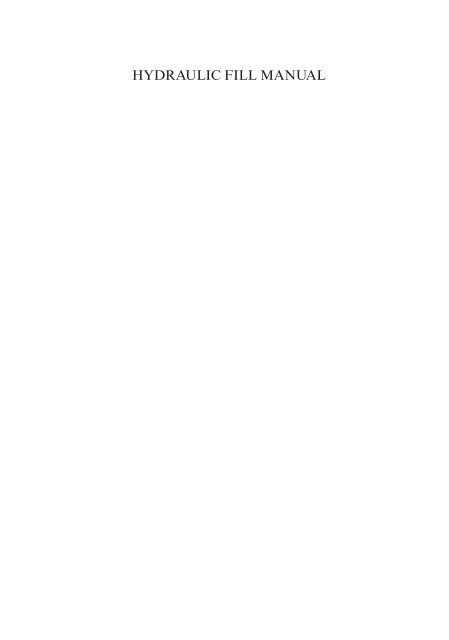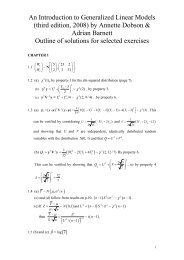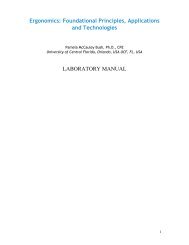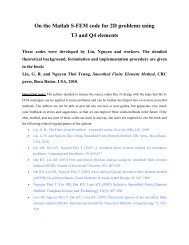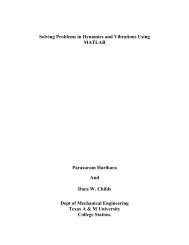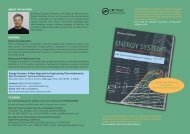Hydraulic Fill Manual
HYDRAULIC FILL MANUAL - CRC Press
HYDRAULIC FILL MANUAL - CRC Press
Create successful ePaper yourself
Turn your PDF publications into a flip-book with our unique Google optimized e-Paper software.
CURNET publication: 244 ISBN: 978-0-415-69844-3Keywords<strong>Fill</strong>, fill area, reclamation area, dredgers, dredgingmethods, compaction, soil improvement, soilinvestigation, soil data, borrow area, fill design,fill strength, fill stiffness, soft soils, liquefaction,monitoring.ClassificationAVAILABILITYCONTENTSTATUSUSERSReaders interestInfrastructural managers and engineers, consultants,planning and other consenting authorities,environmental advisors, Contractors, civil engineers,geotechnical engineers, hydraulic engineers.UnrestrictedAdvice/guidanceCommittee-guidedInfrastructural managers and engineers, consultants, consenting authorities,environmental regulators, Contractors,DisclaimerAll rights reserved. No part of this publication may be reproduced or transmitted in any form or by anymeans, including photocopying and recording, without the written permission of the copyright-holder(CURNET, CIRIA), application for which should be addressed to the publisher. Such written permissionmust also be obtained before any part of this publication is stored in a retrieval system of any nature.This publication is designed to provide accurate and authoritative information in regard to the subjectmatter covered. It is sold and/or distributed with the understanding that neither the authors nor thepublisher is thereby engaged in rendering a specific legal or any other professional service. While everyeffort has been made to ensure the accuracy and completeness of the publication, no warranty or fitnessis provided or implied, and the authors and publisher shall have neither liability nor responsibility to anyperson or entity with respect to any loss or damage arising from its use.Referencing this publicationWhen referencing this publication in other written material please use the information below:Title: <strong>Hydraulic</strong> <strong>Fill</strong> <strong>Manual</strong> (1st edition)Editors: Jan van ‘t Hoff & Art Nooy van der KolffDate: November 2012Publisher: CRC Press/Balkema Taylor & Francis GroupCRC Press/Balkema is an imprint of the Taylor & Francis Group, an informa business© 2012 CURNET, Gouda, The NetherlandsTypeset by V Publishing Solutions (P) Ltd, Chennai, IndiaPrinted and Bound by CPI Group (UK) Ltd, Croydon, CR0 4YY.Published by: CRC Press/BalkemaP.O. Box 447, 2300 AK Leiden, The Netherlandse-mail: Pub.NL@taylorandfrancis.comwww.crcpress.com – www.taylorandfrancis.co.uk – www.balkema.nlLibrary of Congress Cataloging-in-Publication Data<strong>Hydraulic</strong> fill manual for dredging and reclamation works/editors, Jan van ‘t Hoff, Van ‘t Hoff Consultancy B.V.,Zeist, The Netherlands, Aart Nooy van der Kolff, Royal Boskalis Westminster, Papendrecht, The Netherlands.pages cmIncludes bibliographical references and index.ISBN 978-0-415-69844-3 (hardback : alk. paper)1. <strong>Hydraulic</strong> filling. I. Hoff, Jan van ‘t. II. Kolff, Aart Nooy van der.TA750.H85 2012627’.5--dc232012032875ISBN: 978-0-415-69844-3 (Hbk)ISBN: 978-0-203-11998-3 (eBook)
RecommendationThere are many reference books and sources of information on dredging techniquesand dredging equipment but very little has been written solely on planning,design and construction of land reclamation using hydraulic fill. This manual, afirst of its kind, is an ideal reference for all involved in the development of suchinfrastructure projects. Written and reviewed by expert practitioners who havebeen involved in many such projects around the world, this manual provides auseful and practical overview and reference guide for clients, developers, consultantsand contractors who are engaged in planning, design and construction ofreclamation works.A lot of hard work has gone into the development and compilation of this manual.It is our pleasure to be able to recommend this document to all those involvedin the civil engineering and dredging industries.Piet BesselinkExecutive Board Royal Haskoning DHVPayam Foroudi Global Technology Director, Ports and Maritime –Halcrow Group LtdJan de NulRonald PaulManaging Director, Jan de Nul N.V.Chief Operation Officer, Port of Rotterdam AuthorityFrank Verhoeven Member of the Board of Management, Royal BoskalisWestminster N.V.Wim VlasblomProfessor, Emeritus Delft University of Technology
ContentsPrefaceAcknowledgementsNotationAbbreviationsxviixxixxvxxix1 Introduction to the manual 11.1 Land reclamation by hydraulic filling 11.2 History and prospects 11.3 Context and objectives 31.4 Design philosophy 51.5 Structure, content and use 62 Project initiation 112.1 General 112.2 Basic elements of a land reclamation project 132.2.1 Conceptual design 142.2.2 Availability of fill sources 142.2.3 Data collection 142.2.4 Environmental requirements 152.2.5 Feasibility study 162.2.6 Initial project planning 202.2.7 Legal aspects 202.2.8 Types of contracts 202.3 Design 242.3.1 Design phases 242.4 Considerations for selecting construction method 252.5 Systems Engineering 263 Data collection 313.1 Introduction 323.2 Interpretation of data, contractual aspects 343.3 Desk study 373.4 Required data 383.4.1 Bathymetrical or topographical data 383.4.2 Geological and geotechnical information 39vii
Contents3.4.2.1 Geological and geotechnical informationin the borrow area 393.4.2.2 Geological and geotechnical informationof the subsoil in the reclamation area 443.4.3 <strong>Hydraulic</strong>, meteorological, morphologicaland environmental data 443.4.3.1 <strong>Hydraulic</strong> data 453.4.3.2 Meteorological data 463.4.3.3 Morphological and environmental data 493.4.4 Seabed obstructions 503.5 Typical sand search site investigation 513.6 Reporting 543.6.1 Soil and rock classification and description 543.6.2 Soil classification based on CPT measurements 573.7 Use of data during different project stages 593.8 Geostatistical methods 613.8.1 General 613.8.2 Methods 613.8.3 Geostatistical software 634 Dredging equipment 674.1 Introduction 694.2 Dredging equipment 714.2.1 Suction dredging 714.2.2 Mechanical dredging 744.2.3 Other types of equipment 774.2.4 Combinations of equipment or dredge chains 774.3 Operational limitations 794.3.1 Waves and swell 794.3.2 Currents 814.3.3 Hindrance to shipping and other parties 814.3.4 Environmentally driven limitations 824.4 Dredging of fill material 834.4.1 Introduction 834.4.2 Volume and dimensions of borrow area 844.4.3 Minimum thickness of fill deposits 844.4.4 Dredgeability 854.5 Transport of fill 874.5.1 Introduction 874.5.2 <strong>Hydraulic</strong> transport through a pipeline 874.5.3 Transport by trailing suction hopperdredger or barge 884.6 Utilisation characteristics of dredging equipment 894.7 Basis of cost calculation for dredging 96viii
Contents5 Selection borrow area 1015.1 Considerations for the selection of a borrow area 1025.2 Quality of the potential fill material 1035.2.1 Change of the grading as a result of dredging 1045.2.2 Alternative fill materials 1045.3 Data collection in the borrow area 1055.3.1 Data collection for quality assessment 1055.3.2 Data collection for quantity assessment 1065.3.3 Data collection for dredgeability assessment 1065.4 Quantity of fill material available 1075.4.1 Bulking 1075.4.2 Losses 1085.4.3 Slope stability 1095.4.4 Geo-statistical methods 1115.5 Boundary conditions 1116 Planning and construction methods reclamation 1136.1 Planning of the works 1156.1.1 Introduction 1156.1.2 Work preparation 1166.1.2.1 Establishment of project team 1176.1.2.2 Provision of housing and officesfor personnel 1176.1.2.3 Execution of engineering works 1176.1.2.4 Create access to site and developmentof lay-down areas 1186.1.2.5 Preparation and mobilization of equipment 1186.1.3 Construction and monitoring 1186.1.4 Demobilisation, clean-up and maintenance 1196.1.5 Example of a project schedule 1196.2 Work plan for reclamation works 1216.3 Placement methods 1216.4 Construction of containment bunds 1226.4.1 General 1226.4.2 Methods of bund construction 1256.5 Placement of fill material 1296.5.1 Underwater placement in bulk of fill material 1296.5.2 Placement of fill material using a discharge pipeline 1316.5.3 Rainbowing 1346.5.4 Spraying 1366.6 <strong>Fill</strong> mass properties related to method of placement 1376.7 Management of poor quality materials 1396.7.1 Use of cohesive or fine grained materials 1396.7.2 Settling ponds 139ix
Contents7 Ground improvement 1437.1 Introduction 1457.2 Benefits of ground improvement 1457.3 Overview of ground improvement techniques 1467.4 Pre-loading with or without vertical drains 1497.4.1 Purpose and principle of pre-loading 1497.4.2 Vertical drains 1537.5 Compaction 1567.5.1 Introduction 1567.5.2 Vibratory surface compaction 1567.5.3 Deep vibratory compaction 1577.5.3.1 General 1577.5.3.2 Vibratory probes without jets 1617.5.3.3 Vibroflotation 1637.5.4 Dynamic compaction techniques 1677.5.5 Explosive compaction 1707.6 Soil replacement 1727.6.1 Introduction 1727.6.2 Soil removal and replacement 1727.6.3 Stone columns 1737.6.3.1 Purpose and principle 1737.6.3.2 Execution of stone columnsby the vibro-replacement technique 1737.6.4 Sand compaction piles (closed end casing) 1767.6.5 Geotextile encased columns 1767.6.6 Dynamic replacement 1787.7 Admixtures and in-situ soil mixing 1808 Design of reclamation area 1838.1 Design philosophy 1858.2 Basic mass properties 1878.2.1 Strength of fill mass: Bearing capacity and slope stability 1878.2.2 Stiffness of fill mass: Settlements, horizontaldeformations and tolerances 1888.2.3 Density of the fill mass and subsoil: Resistanceagainst liquefaction 1898.2.4 Permeability of fill mass: Drainage capacity 1908.2.5 Platform level: Safety against flooding and erosion 1908.3 Density 1908.3.1 Definition of key parameters 1918.3.2 Density ratios 1928.3.3 The use of densities or density ratios in specifications 1948.3.4 Effect of grain size distribution on the densityof a soil sample 196x
Contents8.3.5 Density measurement 1988.3.5.1 Measurement of reference densities(minimum and maximum density) 1988.3.5.2 Direct measurement of in situ density 1998.3.5.3 Indirect measurement of relative densityby cone penetration testing 1998.3.5.4 Indirect measurement of relative densityby SPT testing 2018.3.5.5 Measurement of in situ state parameter ψby cone penetration testing 2018.3.6 Typical relative density values of hydraulic fill beforecompaction 2028.4 Strength of the fill mass and subsoil (bearing capacityand slope stability) 2028.4.1 Introduction 2028.4.2 Shear strength 2048.4.2.1 High quality fill material 2048.4.2.2 Poor quality fill material 2108.4.2.3 Assessment of shear strength 2158.4.3 Relevant failure modes 2218.4.3.1 Introduction 2218.4.3.2 Safety approach 2228.4.3.3 Analytical calculation models versusFinite Element Method (FEM) 2278.4.3.4 Bearing capacity 2288.4.3.5 Punch through 2328.4.3.6 Squeezing 2348.4.3.7 Slope stability of fill and subsoil 2368.4.3.7.1 Design methods 2368.4.3.7.2 Limit Equilibrium Methods 2388.4.3.7.3 Finite Element Method 2428.4.3.8 Construction of a slope on soft soil 2438.4.3.9 Effect of groundwater flowon slope stability 2448.4.3.10 Earthquakes and slope stability 2508.4.3.11 Stabilising measures for slope stability 2508.4.3.11.1 Optimizing the slopegeometry by usingcounterweight berms 2518.4.3.11.2 Staged construction 2518.4.3.11.3 Soil replacement (sand key) 2528.4.3.11.4 Stone columns, sandcompaction piles 2528.4.3.11.5 Geosynthetics 253xi
Contents8.5 Stiffness and deformation 2548.5.1 Introduction 2548.5.2 Stiffness 2548.5.2.1 General considerations 2548.5.2.2 Stiffness of subsoil 2568.5.2.3 Stiffness of fill material 2578.5.3 Deformations 2588.5.3.1 General considerations 2588.5.3.2 Settlement calculation methods 2608.5.3.3 Additional considerations 2628.5.3.4 Vertical deformation of a reclamation surface 2648.5.3.5 Vertical deformations of structures 2698.5.3.6 Horizontal deformations 2708.5.4 Techniques for limiting settlement 2718.6 Liquefaction and earthquakes 2728.6.1 Overview 2728.6.2 History of understanding 2758.6.3 Flow slides versus Cyclic softening 2808.6.4 Assessing liquefaction susceptibility 2828.6.4.1 Codes & Standards 2838.6.4.2 Loading: Estimating CSR by site responseanalysis 2858.6.4.3 Resistance, Step 1: Susceptibility to largedeformations 2898.6.4.4 Resistance, Step 2: Evaluation of CRR 2928.6.5 Movements caused by liquefaction 2968.6.5.1 Slope deformations 2968.6.5.2 Lateral spreads 2998.6.5.3 Settlements 3008.6.6 <strong>Fill</strong> characterization for liquefaction assessment 3038.6.6.1 Necessity for in situ tests 3038.6.6.2 Required number of CPT soundings 3058.6.6.3 CPT calibration 3068.6.6.4 Supporting laboratory data 3078.6.7 Note on soil type (Calcareous and othernon-standard sands) 3079 Special fill materials and problematic subsoils 3099.1 Cohesive or fine-grained fill materials 3119.1.1 Introduction 3119.1.2 Segregation of fines 3139.1.3 Soft clay or soft silt 3159.1.3.1 Suitability of soft (organic) clayor silt as fill material 316xii
Contents9.1.3.2 Workability of clay 3169.1.3.3 Effects of winning method 3179.1.3.4 Measures to improve the fill propertiesafter disposal 3189.1.3.5 Construction aspects of soft soils in caseof application above the waterline 3349.1.3.6 Construction aspects of soft soils in caseof application below the waterline 3369.1.4 Stiff clay or silt 3369.2 Carbonate sand fill material 3429.2.1 Introduction 3429.2.2 Origin and composition of carbonate sands 3439.2.3 Typical properties of carbonate sands 3449.2.4 Mechanical behaviour of carbonate sands 3499.2.5 The use of carbonate sand as fill 3579.2.5.1 Typical behaviour during dredgingand hydraulic transport 3579.2.5.2 Cone Penetration and StandardPenetration testing in carbonate sands 3599.2.5.3 Laboratory testing 3619.2.5.4 Field compaction 3639.3 <strong>Hydraulic</strong> rock fill 3649.3.1 Introduction 3649.3.2 Lump size 3649.3.3 Compaction and measurement of compaction result 3649.3.4 Grading 3679.3.5 Fines 3679.3.6 Wear and tear 3689.3.7 Pumping distance during rock dredging 3689.3.8 Specifications rock fill 3699.4 Problematic subsoils 3709.4.1 Sensitive clay 3709.4.2 Peat 3729.4.3 Glacial soils 3749.4.4 Sabkha 3759.4.5 Karst 3799.4.6 Laterite 38310 Other design items 38710.1 Introduction 38810.2 Drainage 38810.2.1 Infiltration 39010.2.2 Surface runoff 39010.2.3 Artificial drainage systems 391xiii
Contents10.3 Wind erosion 39410.4 Slope, bank and bed protection 39810.5 Interaction between reclamation and civil works 40010.5.1 General 40010.5.2 Foundations 40010.5.3 Construction sequence 40110.5.4 Impact on existing structures 40210.6 Earthquakes 40510.7 Tsunamis 40911 Monitoring and quality control 41311.1 Introduction 41411.2 Quality Control Plan 41711.3 Monitoring and testing 42011.3.1 Geometry 42011.3.2 <strong>Fill</strong> material properties 42011.3.2.1 Grain size distribution 42011.3.2.2 Minimum and maximum dry densities 42211.3.2.3 Mineralogy 42211.3.3 <strong>Fill</strong> mass properties 42211.3.3.1 Shear strength 42211.3.3.2 Stiffness 42511.3.3.3 Density, relative compactionand relative density 42811.3.4 Environmental monitoring 43112 Technical specifications 43312.1 Introduction 43412.2 Roles and responsibilities 43412.3 Checklist project requirements 43712.4 Commented examples of technical specifications 44212.4.1 Introduction 44212.4.2 Description of the works 44312.4.3 Standards 44412.4.4 Data collection (see Chapter 3) 44412.4.5 Dredging equipment and working method(see Chapter 4) 44512.4.6 Selection borrow area—quality fill material(see Chapter 5) 44712.4.7 Construction methods reclamation area(see Chapter 6) 45012.4.8 Environmental impact 45212.4.9 Design of a land reclamation (see Chapter 8) 45312.4.10 Ground improvement (see Chapter 7) 458xiv
Contents12.4.11 Special fill materials (see Chapter 9) 46112.4.12 Other design aspects (see Chapter 10) 46212.4.13 Monitoring and quality control (see Chapter 11) 46312.4.13.1 Geometry 46412.4.13.2 Testing fill material properties(see Section 11.3.2) 46612.4.13.3 Testing fill mass properties(see Section 11.3.3) 46712.4.13.4 Settlement monitoring (see Appendix B.5.3) 47012.4.13.5 Performance testing 47012.4.13.6 Reporting 47212.4.13.7 Monitoring and Quality Control Program(see Section 11.2) 472AppendicesA Equipment 477B Field and Laboratory Tests 529C Correlations and Correction Methods 593D Geotechnical Principles 609References 627xv
Preface<strong>Hydraulic</strong> fills are often used to reclaim land for large infrastructure projects suchas airports, harbours, industrial and domestic areas and roads. The quality of theborrow material and construction methods are crucial for the quality of the endproduct. The end product or application will ask specific performance requirementsand the characteristics of the fill mass will determine how well these performancecriteria are met.Given the fundamental importance of hydraulic fill to infrastructure projects, aneed was felt for a single volume bundling the wide range of the design and constructionaspects of hydraulic fills. The <strong>Hydraulic</strong> <strong>Fill</strong> <strong>Manual</strong> is the result.The <strong>Manual</strong> represents the concerted effort of Clients, Consultants and Contractorsto arrive at a rational and transparent process of project initiation, design,specification and construction of hydraulic fills. The aim of the book is to pointthe way for each particular project to realise an optimum design based on:− the available quality and quantity of fill material;− boundary conditions like the soil conditions, bathymetry, wave climate and tectonicsetting of the proposed fill area;− the selection of dredging equipment with its related construction methods;− appropriate functional and performance requirements.Such an optimum design is achieved by making the process from project initiationto construction a clear, iterative process. The <strong>Manual</strong> promotes this iterative processin which the results of each step are compared with the starting points and resultsof the previous step and/or with the functional requirements of the project.This process follows the “System Engineering” approach, a method often appliedto the realisation of engineering projects. The underlying idea of this approach isthat process transparency and the implementation of sound engineering principlesshould lead the involved parties to suitable specifications for the construction ofthe hydraulic fill. Suitability of specifications implies that the functional requirementsof the fill mass will be met within the wanted safety margins (and, hence,without excessive costs), but at the same time ensures that the hydraulic fill can beconstructed in a feasible and economic manner. This will reduce excessive costs,unwanted disputes, arbitrations and lawsuits.xvii
PrefaceAs it is the intention of the authors that the <strong>Manual</strong> can be used all over theworld on land reclamation projects by hydraulic filling it will not necessarilyadhere to (local) standards, norms and/or Codes of Practice. When consideredto be relevant references to such documents will be made, but this will belimited to generally accepted and often used systems like the American Standards,the British Standards and/or the European Codes. It may neverthelessbe important to be fully informed about the local codes and standards as theymay form part of the jurisdiction of the country in which the project has to berealized.For Clients the <strong>Manual</strong> presents the most important elements of a land reclamationproject (planning, design, data collection, legal and contractual aspects)and explains how the land reclamation forms part of an overall cost-benefitanalysis. Clients and Consultants will also learn that to make a project feasible,the fill material may not have to be restricted to sandy material but thatxviii
Prefacewith certain technical measures and under certain conditions, cohesive and finegrainedmaterials (clay, silt) also may be used. The use of carbonate sands is alsohighlighted.The <strong>Manual</strong> also advises about the various types of dredging equipment, fill materialand soil improvement techniques and what geotechnical data are required forproduction estimates of dredging equipment and for analysing the suitability of fillmaterial. Emphasis is placed on how to translate performance and functional requirementsinto a measurable properties of the fill mass, with special attention focussed ondensity, strength and stiffness characteristics and to liquefaction and breaching.The <strong>Manual</strong> concludes with examples of practical geotechnical specifications forthe construction of a fill mass.Readers are warned that for proper understanding of design issues some backgroundknowledge in geotechnical engineering is required. For specialist knowledgethe reader is referred to handbooks on these subjects.xix
AcknowledgementsThis publication is the result of a joint project of Clients, Consultants andContractors from Belgium, United Kingdom and the Netherlands. The overallmanagement has been performed by CUR Building & Infrastructure. Themanual has been reviewed by CIRIA/UK.Authors/reviewersKen BeenRik BisschopErik BroosEgon BijlsmaHenk ClooJurgen CoolsDavid Dudok van HeelArnoud van GelderReimer de GraaffJarit de GijtRobert de HeijIlse HergardenJan van ‘t HoffRichard de JagerDirk-Jan Jaspers FocksMike JefferiesWouter KarremanLieve De KimpeEdwin KoeijersRob LohrmannJoop van der MeerPiet MeijersPatrick MengéMario NieseArt Nooy van der KolffCissy de RooijRob RozingBerten VermeulenGolder AssociatesArcadisPort of Rotterdam AuthorityArcadisRoyal Haskoning DHVRoyal Haskoning DHVRotterdam MunicipalityConsultancyRoyal Haskoning DHVArcadisRotterdam Municipality/DelftUniversity of TechnologyWitteveen + BosRoyal Haskoning DHVVan ‘t Hoff Consultancy bvRoyal Boskalis Westminster N.V.Witteveen + BosGolder AssociatesVan Oord Dredging and MarineContractorsVan Oord Dredging and MarineContractorsRotterdam Municipality ConsultancyWitteveen + BosVan Oord Dredging and MarineContractorsDeltaresDEME Group/DredgingInternationalRoyal Haskoning DHVRoyal Boskalis Westminster N.V.Royal Boskalis Westminster N.V.ArcadisJan de Nulxxi
AcknowledgementsEditorsPeer reviewersCIRIA ProjectManagers peerreviewsReview EnglishtranslationJan van ‘t Hoff & Art Nooy van der KolffIn response to a request from CUR Bouw & Infra CIRIAhas managed a peer review of this manual. This review wasconducted by the following UK experts:John AdrichemRoyal Haskoning DHVKen BeenGolder AssociatesNick BrayHR WallingfordGijsbert Buitenhuis Royal Haskoning DHVChris CapenerRoyal Haskoning DHVChris ChiverrellCIRIAScott DunnHR WallingfordPayam ForoudiHalcrowHelge FrandsenRoyal Haskoning DHVPrasad Gunawardena Mott MacDonaldGreg HaighArupMike JefferiesGolder AssociatesDavid JordanScot Wilson/HR WallingfordRoderick NicholsHalcrowPhilip SmithRoyal Haskoning DHVKristina GamstGillian WadamsMarsha CohenTechnicalreviewChris ChiverrellAad van den ThoornCIRIACURNETExecutivesteering boardJurgen CoolsRoyal Haskoning DHVJarit de GijtRotterdam Municipality/Delft University of TechnologyJan van ‘t HoffVan ‘t Hoff Consultancy bvRené KolmanIADCJoop Koenis (upto Dec. 2010) CUR Bouw & InfraDirk LugerDeltaresArt Nooy van der Kolff Royal Boskalis Westminster N.V.Daan Rijks (upto Dec. 2009) Royal Boskalis Westminster N.V.Ger Vergeer (from Jan. 2011) CUR Bouw & InfraWim Vlasblom (chair) Delft University of Technologyxxii
AcknowledgementsProjectsponsorsThe overall project management has been performed by CURBuilding & Infrastructure: Joop Koenis (up to Dec. 2010) en GerVergeer (from Jan. 2011)Ministry of Infrastructure and the Environment, InternationalDredging Association (IADC) , China CommunicationsConstruction Company (CCCC), Foundation FCO-GWW,Port of Rotterdam Authority, Inros Lackner, PAO DelftUniversityCUR wishes to thank the following organisations for providing photographs:DEME, Jan de Nul, Royal Boskalis Westminster, Van Oord Dredging and MarineContractors, Port of Rotterdam Authority.xxiii
Notationa g= Ground acceleration (m/s 2 )B = Bulk Modulus (kPa)B q = CPT excess pore pressure ratio B q= (u c– u 0)/(q t– σ v0) (−)c′ = Effective cohesion (kPa)c u= Undrained shear strength (kPa)c v= Vertical coefficient of consolidation (m 2 /year)c h= Horizontal coefficient of consolidation (m 2 /year)c′ k= Characteristic effective cohesion (kPa)c u(t) = Undrained shear strength at time t after loading (kPa)c u,0= Initial undrained shear strength (kPa)c u,k= Characteristic undrained shear strength (kPa)cuu = Undrained shear strength at the upper side(kPa)of a soft layercul = Undrained shear strength at the lower side(kPa)of a soft layerC α= Peak ground acceleration (m/s 2 )C α= Secondary compression index (−)C c= Compression index (−)C c= Coefficient of curvature (−)C r= Recompression index (−)C u= Coefficient of uniformity (−)d e= Equivalent diameter of the zone of influence of a (m)draind w= Equivalent diameter of a cylindrical drain column (m)d q, d c= Depth factors (−)D 50= Mean grain size (mm)e = Void ratio (−)e 0= Void ratio of layer with initial thickness h 0 (−)e p= Void ratio of layer with thickness h p(−)after primary settlementE = Modulus of Elasticity (kPa)E dyn= Dynamic Modulus (kPa)E y= Young’s Modulus (kPa)E DMT= Dilatometer Modulus (kPa)E PLT= Plate Load Test Modulus (kPa)E PMT= Pressiometer Modulus (kPa)E sor E oedor M = Constrained Modulus(kPa)E sec= Secant Modulus (kPa)xxv
NotationE tan= Tangent Modulus (kPa)E u= Undrained Modulus (kPa)E 0= Young’s Modulus at very small deformations (kPa)E 50= Young’s Modulus at 50% of the failure stress (kPa)F R= Friction Ratio CPT test (−)G = Shear Modulus (kPa)G 0= Shear Modulus at very low strain (kPa)G 50= Shear Modulus at very low strain (kPa)h 0= Initial thickness of layer (m)h p= Thickness of the considered layer after primary (m)settlementH = Layer thickness (m)i q, i c, i γ= Inclination factors (−)I S50= Point load strength (MPa)I P= Plasticity index (−)I C= Consistency index (−)I L= Liquidity index (−)K o= Coefficient of active earth pressure at rest (−)k h= Horizontal seismic coefficient (−)k v= Vertical seismic coefficient (−)k y= Yield coefficient (−)M = Earthquake magnitude (−)M, E sor E oed= Constrained Modulus (kPa)M L= Local magnitude (−)M S= Surface wave magnitude (−)M W= Moment magnitude of earthquake (⋅)n = Porosity (−)n 0= Initial porosity (−)N′ = Number of blows per per foot (300 mm)(−)penetration of SPTN k= Empirical factor to correlate the undrained(−)shear strength to the cone resistanceN q, N c, N γ= Bearing capacity factors (−)p′ = Mean effective stress (kPa)p a= Atmospheric pressure (kPa)q allow= Allowable load (kPa)q c= Measured cone resistance (MPa)q ck= Characteristic cone resistance for liquefaction assessment (MPa)q t= Corrected cone resistance (MPa)Q= Dimensionless CPT resistance based on mean (−)stress, Q = (q t– σ v0)/σ′ v0Q u= CPT resistance modified on pore pressure (−)Q u= Ultimate bearing capacity (kPa)xxvi
Notationq u= Unconfined compressive strength (kPa)r d= Response coefficient (−)R e= Relative void ratio (−)R n= Relative porosity (−)R c= Degree of compaction (−)s r= Residual undrained shear strength (kPa)s q, s c, s γ= Shape factors (−)S = Degree of saturation (−)S min= Minimum settlement to be reached at time of handover(m)S total= Total primary settlement (m)t = Time (year)t p= Time at end of primary settlement (full(year)consolidation)t f= Time at which the secondary compression(year)has to be calculatedT h= Time factor for horizontal consolidation (−)T s= Fundamental period (s)T v= Time factor (−)u 2= Pore pressure measured behind the cone (kPa)u 0= In situ pore pressure (kPa)U v= Average degree of consolidation due(−)to vertical drainageUCS = Unconfined compressive strength (MPa)U h= Average degree of consolidation due(−)to horizontal drainageU vh= Average degree of consolidation (−)U (t)= Degree of consolidation at time t after loading (−)w = Water content (−)wL = Liquid limit (−)wP = Plastic limit (−)α = Peak horizontal ground acceleration (m/s 2 )γ = Volumetric weight (kN/m 3 )γ dry= Dry unit weight (kN/m 3 )γ sat= Saturated unit weight (kN/m 3 )ε g= Shear strain (−)Δe= Change in void ratio from a layer with initial void (−)ratio e 0Δh = Compression of layer with initial thickness h 0(m)Δh s= Secondary compression of layer with thickness h p(m)Δσ ′= Effective stress increment in the middle of the (kPa)considered layerΔσ ′ ref= Reference stress (usually taken equal to 1 kPa) (kPa)xxvii
NotationΔS allow= Allowable residual settlement at time of hand-over (m)λ = Slope of CSL for semi-log idealization (−)ρ = Density (kg/m 3 )ρ b= Bulk density (kg/m 3 )ρ d= Dry density (kg/m 3 )ρ g= Particle density (kg/m 3 )ρ s= Density of solid particles (kg/m 3 )ρ sat= Saturated density (kg/m 3 )σ = Normal stress (kPa)σ ′ 0= Initial effective stress in the middle of the(kPa)considered layer with initial thickness h 0σ ′ m= Mean effective stress (kPa)σ ′ n= Effective normal stress (kPa)σ ′ p= Pre-consolidation stress in the middle of the (kPa)considered layer with initial thickness h 0σ v0= Total stress (kPa)σ ′ v= Effective vertical stress at foundation level next to (kPa)foundationσ ′ v0= Effective vertical stress (kPa)Δσ ′ v= Increase effective vertical stress due to loading after (kPa)full consolidationσ ′ v,0= Effective vertical stress at foundation level (kPa)ϕ′ = Effective friction angle (°)ϕ′ crit= Critical state friction angle (°)ϕ′ k= Characteristic effective friction angle (°)ϕ′ max= Peak effective friction angle (°)ϕ′ s= Secant friction angle (°)ϕ u= Undrained friction angle (°)τ = Shear strength (kPa)ψ = State parameter (−)xxviii
AbbreviationsADCP Acoustic Doppler Current ProfilersCBR California Bearing RatioCIRIA Construction Industry Research and Information AssociationCPT Cone Penetration TestCRR Cyclic Resistance RatioCSL Critical State LocusCSR Cyclic Stress RatioCSWS Continuous Surface Wave SystemCTD Conductivity, temperature, depth meterCUR Centre for Civil Engineering, Research and CodesDC Dynamic CompactionDIN German Institute for StandardizationDO Dissolved OxygenDSM Deep Soil MixingEAU Recommendations of the Committee for Waterfront StructuresHarbours and Waterways EAU 2004EC7 Eurocode 7EC Explosive CompactionECM Electromagnetic Current MeterEMS European Macroseismic ScaleFEM Finite Element MethodFS Factor of SafetyFS Safety Against InstabilityFS LCRR/CSR = Safety Against Failure by LiquefactionGEC Geotextile Encased ColumnsGWL Ground Water LevelHEIC High Energy Impact CompactionISSMGE International Society for Soil Mechanics and GeotechnicalEngineeringLAT Lowest Astronomical TideLEM Limit Equilibrium MethodMBES Multibeam Echo SoundingMDD Maximum Dry DensityMPM Material Point MethodMSL Mean Sea LevelNTU Nephelometric Turbidity UnitsNCEER National Center for Earthquake Engineering ResearchOCR Over Consolidation RatioPGA Peak Ground Accelerationxxix
AbbreviationsPIANCPLTPVDRICRQDSASWSCRSLSSPTSSMSSSTCRTSSULSZLTPermanent International Commission for Navigation CongressesPlate Load TestPrefabricated Vertical DrainRapid Impact CompactionRock Quality DesignationSpectral Analysis of Surface WavesSolid Core RecoveryServiceability Limit StateStandard Penetration TestShallow Soil MixingSide Scan SonarTotal Core RecoveryTotal Suspended SolidsUltimate Limit StateZone Load Testxxx
Chapter 1INTRODUCTION TO THE MANUAL1.1 Land reclamation by hydraulic fillingLand reclamation is generally defined as the process of creating new land by raisingthe elevation of a seabed, riverbed or other low-lying land (‘filling’) or by pumpingout the water from a watery area that is enclosed by dikes (‘polder construction’).Land reclamation by filling may be undertaken by dry earth movement, but alsoby hydraulic filling. <strong>Hydraulic</strong> filling is defined as the creation of new land by thefollowing consecutive activities:1. dredging of fill material in a borrow area or dredging area by floating equipment(dredgers);2. transport of fill material from the borrow area to the reclamation site bydredger, barge or pipeline;3. placement of fill material as a mixture of fill material and (process) water in thereclamation area.It is the hydraulic filling that forms the main subject of this <strong>Manual</strong>. For informationon other reclamation methods like dry earth movement or the constructionof polders reference is made to other publications like manuals, guides, stateof the art reports and/or codes of practice that more specifically deal with thesetechniques.In most cases land reclamation will be a part of a more comprehensive projectsuch as the construction of a port, an airport, a housing project or an industrialcomplex. Whereas superstructures will not be discussed in this <strong>Manual</strong>, their presencewill impose certain requirements on the quality of the reclaimed land, itsresponse to external forces such as currents, waves, precipitation and wind and itsability to withstand hazards such as earthquakes and tsunamis.1.2 History and prospectsArchaeological evidence indicates that land reclamation is not a recent invention,but has existed for thousands of years. Some 2000 years ago inhabitants of theswampy and tidal areas along the Wadden Sea in the north of The Netherlandsand Germany lived on so-called ‘terpen’ or ‘wierden’, artificial dwelling moundsbuilt to protect themselves against flooding in periods of high water levels. Furtherattempts to prevent their agricultural land from being flooded by the sea includedthe construction of dikes between those dwelling mounds.1
<strong>Hydraulic</strong> <strong>Fill</strong> <strong>Manual</strong>Around 1500 A.D. a new method of land reclamation came into use: “Polders”were constructed by building a ring dike in shallow watery areas, after which thewater was removed from the enclosed low-lying area by windmill-driven pumps.Once steam engines became available in the 19th century some of the windmillswere replaced by pumping stations.A transformational moment came with the development of the modern centrifugalpump that enabled the current large-scale reclamation projects by hydraulicfilling. According to the International Association of Dredging Companies (Terraet Aqua, 2005) one of the first major reclamation works (Bay of Abidjan, IvoryCoast) was carried out in the 1960s.As a result of the strong growth of the world’s population and the subsequenturbanisation and economic development, in particular in densely populatedcoastal areas, the last decades have witnessed an ever-increasing demand fornew land. This demand has resulted in a large number of reclamation projectsranging from numerous small-scale projects all over the world to well-known,large-scale projects such as the Palm Island Project in Dubai or the construction ofMaasvlakte 2 in Rotterdam Europoort, The Netherlands (see Figure 1.1).Demographic forecasts suggest that in the foreseeable future this demand for newland will remain or even increase, see Figure 1.2.Figure 1.1 Construction of Maasvlakte 2 in progress, Rotterdam Europoort, The Netherlands,October 2011.2
Introduction to the manual1.000.000.000Reclamation Contract Volume [m 3 ]100.000.00010.000.0001975 1980 1985 1990 1995 2000 2005 2010Year of completionFigure 1.2 Trend of reclamation contract volumes over the past 30 years.1.3 Context and objectivesThis <strong>Hydraulic</strong> <strong>Fill</strong> <strong>Manual</strong> is written to supply the wants of the dredging industryto create a handbook that helps to improve the understanding between the variousparties (i.e., Clients, Consultants and Contractors) involved in a hydraulic fillproject. It contains the latest developments in the field of design and constructionof hydraulic fills and presents clear guidelines for initiation, design and constructionof a hydraulic fill project.The design and construction of a hydraulic fill project requires specific knowledgeof a wide variety of disciplines, such as hydraulic, geotechnical and environmentalengineering in combination with practical know-how and experience in dredgingand filling techniques.Moreover, a new generation of dredging equipment, increasing awareness of the marineenvironment and the tendency to reduce construction time (i.e., return on investmentperiod) will affect the design and construction methods requiring new standards.Worldwide experience indicates that in recent years the technical specificationsof reclamation projects have become more stringent. No rational basis for such atrend exists as the intended use of this newly created land (i.e., functional requirements)has not changed significantly nor has an increase of failures been reported.In a number of cases this trend has led to inadequate and conflicting specifications,to construction requirements that could not be met and/or to excessive costs for3
<strong>Hydraulic</strong> <strong>Fill</strong> <strong>Manual</strong>fill treatment and testing. These developments frustrate the tender process, causeserious problems during construction and quality control and may lead to longlasting,costly arbitration.This <strong>Hydraulic</strong> <strong>Fill</strong> <strong>Manual</strong> has been written to avoid these problems. It includestheoretical and practical guidelines for the planning, design, construction andquality control of hydraulic fills.The <strong>Manual</strong> covers the interfaces between the areas of interest of the contractualparties usually involved in reclamation projects (see Figure 1.3). It will:− enable the Client to understand and properly plan a reclamation project;− provide the Consultant with adequate guidelines for design and quality control;− allow the Contractor to work within known and generally accepted guidelinesand realistic specifications.This <strong>Manual</strong> is believed to be the first handbook to date that covers all theseaspects that are relevant to the construction of hydraulic fills.The authors and reviewers have endeavoured to gather the most up-to-date knowledgeregarding the design and construction of hydraulic fills with the goal thatwith time this <strong>Manual</strong> will be a standard for all parties involved in the implementationof hydraulic fill projects.The structure of the <strong>Manual</strong> assumes that the design and construction of a hydraulicfill should be a rational process that ultimately results in the best and mosteconomical match between the specified properties of the land reclamation, therequirements imposed by its future use and the environment in which it is located.ClientConsultantContractorFigure 1.3Focus of the <strong>Manual</strong>: Interfaces betweenthree contractual partners.4
Introduction to the manual1.4 Design philosophyLand reclamation projects are undertaken for various purposes and under varyingconditions. The performance requirements imposed on a fill depend on the futureuse of the reclamation and, hence, they vary for each individual project.Boundary conditions are often site and project specific as well. Physical site conditions,such as wave climate, currents, water depth, subsoil properties and thevulnerability of the environment to dredging and reclamation activities will differfrom one site to another. The quality and quantity of the fill available for constructionwill strongly depend on the location of the project. These conditions will notonly affect the design of a reclamation, but they must also be taken into accountwhen selecting the most suitable dredging equipment and construction method.A rational design must integrate the functional and performance requirementsconsidering the boundary conditions of the project in order to adequately specifythe geometry and properties of the fill mass. The same rationality must be appliedwith respect to the construction of the reclamation requiring an appropriate selectionof equipment and working method.Functional and performance requirementsA functional requirement defines what a system must do, while a performancerequirement specifies something about the system itself and how wellit performs its function. A fill mass (and its subsoil) can be regarded as asystem with functional and performance requirements.Starting point of a design must always be the future land use. The functionalrequirements of the fill mass follow directly from the intended use of the fillarea. These functional requirements may be formulated in general terms (forinstance: “the reclamation area must accommodate an airfield with runways,aprons, a terminal building and a traffic control tower”), but can also be morespecific (for instance: “the fill mass must support a structure founded on a stripfooting having a width of 1.5 m, an embedment depth of 1.0 m and a bearingload of 80 kPa”) which may vary over the area depending on the lay-out ofthe future development.The functional requirements and the design of the superstructures (i.e., theirUltimate Limit State and/or Serviceability Limit State, see section 8.4.1) leadto performance requirements of the fill mass such as maximum allowablesettlement of the superstructures (buildings, roads, storage areas, runways,revetments, tunnels, etc.), and sufficient safety against slope failure or liquefaction.The required basic mass properties like strength, stiffness, densityand permeability can be derived from these performance requirements.5
<strong>Hydraulic</strong> <strong>Fill</strong> <strong>Manual</strong>The definition of functional requirements and their subsequent translationinto performance criteria form the basis of System Engineering, see section2.5, which may be used as a tool to control the development cycle of a reclamationproject.Following an approach in terms of functional and performance requirements, thedesign of a reclamation project becomes an iterative process. Functional requirements,dictated by structural criteria and other project-dependent boundary conditions,will not be discussed in this <strong>Manual</strong>.1.5 Structure, content and useRather than following a chronological sequence of events (project initiation,design and construction), the structure chosen for this <strong>Manual</strong> intends to put themain emphasis on the design of a land reclamation. To that end the first chaptersdescribe not only the collection of data required for the design but also presentbasic information on dredging equipment and construction methods before touchingupon the design aspects.The <strong>Manual</strong> concludes with a discussion of the technical specifications that resultfrom a design. Additional information can often be found in the referenced Appendices.Figure 1.4 illustrates the set-up of this <strong>Manual</strong>.Following the scheme of Figure 1.4 the contents of this <strong>Manual</strong> can briefly besummarised as follows:Chapter 2: Project initiation, gives an overview of the most relevant elements inthe procedure to realise a reclamation project and the way they are related to eachother. It introduces the development cycle to realize a project, including the iterativenature of that cycle and concludes with an illustrative scheme of activitiesleading to the construction of a reclamation project.Chapter 3: Data collection, presents the data required for the design of a hydraulicfill project. It deals not only with the type of information needed for the design, butalso with the methods to collect the information, the reporting and the processingof data.Commonly used dredging equipment and its use can be found in Chapter 4: Dredgingequipment. Possibilities and limitations of the various types of dredgers and theirvulnerability to the physical conditions of the project site are also included.6
Introduction to the manual2. Project initiation3. Data collection4. Dredging equipment5. Selection borrow area6. Planning and construction methods reclamation7. Ground improvement8. Design9. Special fill materials and problematic subsoils10. Other design items11. Monitoring andquality control12. SpecificationsFigure 1.4 Structure of the <strong>Manual</strong>.The feasibility of a project strongly depends on the availability of sufficient suitablefill material in the vicinity of the reclamation site. Chapter 5: Selection borrowarea, describes the most important criteria for the selection of a borrow area.Chapter 6: Planning and construction methods reclamation, deals with theconstruction methods of a reclamation area. This not only includes the depositionof the material, but also the planning, preparation and monitoring of theoperations.In the case where the existing subsoil and/or the fill behaviour do not meetthe requirements, ground improvement may be required. Chapter 7: Groundimprovement, gives an overview of the most relevant ground improvementtechniques.7
<strong>Hydraulic</strong> <strong>Fill</strong> <strong>Manual</strong>Chapter 8: Design, discusses the geotechnical design of a land reclamation. Themain sections deal with density, (shear) strength, stiffness and deformations of thefill mass. A special section of this chapter is dedicated to the phenomena liquefactionand breaching.In some areas of the world land reclamation projects have to be undertaken usingcohesive materials or carbonate sands rather than with the more frequently encounteredquartz sands. Furthermore, some subsoils may exhibit a different behaviourwhen loaded by fill. Chapter 9: Special fill materials and problematic subsoils,describes the behaviour of these special fill materials and problematic subsoils.In addition to the geotechnical behaviour, a design should also take into accountaspects like drainage of the reclaimed area, wind erosion, and slope, bed and bankprotection. A short introduction to these subjects and some relevant references arepresented in Chapter 10: Other design items.Chapter 11: Monitoring and quality control, is about monitoring and quality controlrequirements during and after construction of the reclamation.Finally, Chapter 12: Specifications, makes recommendations for specifying theconstruction of a hydraulic fill area which logically follow from the engineeringphilosophy adopted in this <strong>Manual</strong>.8


